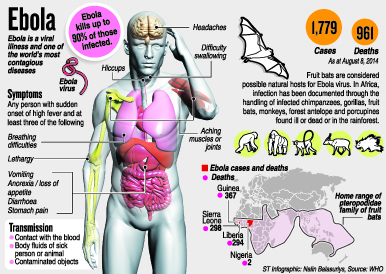News
Hospitals, airports, on Ebola alert as WHO declares emergency
All hospitals have been issued detailed instructions on how to deal with a patient suspected of having the dreaded Ebola virus, with Sri Lanka on high alert to minimise chances of the virus entering the country as the World Health Organisation declared aglobal state of emergency.
Lanka on high alert to minimise chances of the virus entering the country as the World Health Organisation declared aglobal state of emergency.
“The disease is moving faster than we can control it,” WHO Director-General, Dr. Margaret Chan said yesterday.
With tightened security at Bandaranaike International Airport, a 24-hour medical unit has been set up to examine possible carriers of the virus which has a high mortality rate and has no known cure.
“We will be working together with the Department of Immigration which will inform us of any suspected patients arriving in the country.
“Then they will be screened to see if they are low-risk, medium-risk or high-risk patients. High-risk patients will be taken to the Infectious Diseases Hospital where they will be treated under special conditions,” said the Director of Quarantine at the Ministry of Health, Dr. L. B. H. Denuwara.
“There are very few people travelling from countries of infection to Sri Lanka,” the ministry’s Epidemiology Unit Director Dr. Paba Palihawadana said reassuringly. “We are working with Immigration to monitor people coming from these places.”
The WHO stated that as of this Monday, 1711 cases including 932 deaths have been reported in four countries this year.
“This is the largest outbreak of the Ebola virus since 1976,” said Consultant Community Physician Dr. Ranjith Batuwanthudawa.
The WHO’s Dr. Chan said the epidemic was “the largest, most severe and most complex outbreak in the nearly four-decade history of this disease”.
Until this year, the highest number of cases was reported in 2007 in the Democratic Republic of Congo where 264 cases were reported, out of which 187 were fatal, said Dr. Batuwanthudawa, adding that still the virus was only found in West and Central Africa.
Ebola is characterised by the sudden onset of fever, intense weakness, muscle pain, headache and sore throat. This is followed by vomiting, diarrhoea, rash, impaired kidney and liver function, and in the worst cases, unstoppable haemorraging.
Dr. Batuwanthudawa said that initially humans were infected by the virus through animals, with fruit bats and monkeys considered to be the natural carriers, but that now the virus could be passed from human to human also through bodily fluids such as blood and semen. The disease could also be transmitted by direct contact with an infected person.
Health officials who treat patients have the possibility of contracting the disease, Dr. Batuwanthudawa said.
He stressed that Sri Lanka is at low risk and all possible measures are being taken to stop the virus from entering the country.
To ensure that Sri Lankans are informed of the dangers of infection while travelling, leaflets with details regarding the virus are being distributed at the Bandaranaike International Airport.
Ebola was first reported in 1976 in Sudan and the Democratic Republic of the Congo. The virus was named after the Ebola River in Congo, scene of one of the first outbreaks.
| Casualties of this year’s outbreak by country are - Guinea (reported) 495 cases (351 confirmed, 133 probable, and 11 suspected), including 363 deaths |

